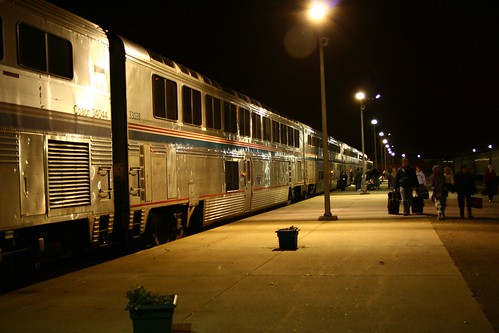Despite its unreliability and low frequency of service, Amtrak's Empire Builder often faces capacity issues. The train serves 45 stations along the way from Chicago to the Pacific Northwest, resulting in an immense possible number of trip combinations. Some trips become impossible to book because of other riders who overlap on part of the route. Despite the common wisdom, not everyone is traveling the entire 2,200-mile distance: The average trip is around 720 miles, taking about 15 hours.
In recent years, stations in western North Dakota have seen growing ridership because of the oil boom in the Bakken formation. This past year, Williston—smack in the middle of the train's route—surpassed Minot to become the busiest station in the state of North Dakota. While the numbers aren't huge (Williston sees about 82 boardings and alightings each day), it does make a significant impact on a train that's only running once daily in each direction and is making 44 other stops along the way. Calls for extra capacity on the line have become common in recent years, and two weeks ago, Montana's two senators reiterated that request.
The fleet of locomotives and rail cars used by the Empire Builder is actually pretty large. Because the journey between Chicago and the coast takes about 2 days, there are 4 or 5 sets of equipment in use at any given time. The typical train is 2 locomotives plus 11 cars, and that grows to 12 cars for the run between Chicago and Saint Paul—an extra car gets added to the train for that segment because of typically higher demand between those large metropolitan areas.
Going by the consist listed on Wikipedia, the minimum fleet size is 67 vehicles, broken down like this (not counting spares for use during maintenance periods):
- 10 GE Genesis locomotives
- 5 baggage cars (Seattle)
- 5 transitional crew/sleepers
- 5 coach/baggage cars (Portland)
- 15 sleepers
- 17 coaches (3x per train plus 2x CHI-MSP cars)
- 5 diners (Seattle)
- 5 sightseer lounge/cafes (Portland)
(It is a lot of money, but the train fleet listed above is probably cheaper than a single Boeing 747. A new individual set of equipment probably has a value around $55 million.)
Other options involve adding extra cars to each existing train. These wouldn't help solve the problems with on-time reliability or frequency of service, but they would help alleviate capacity problems. Amtrak always claims that they don't have much equipment to spare, so it might be an issue to lengthen the Builder. Since there are 5 sets of equipment needed for regular operation, adding one car per train means you must find 5 rail cars. This really shouldn't be a problem, but Amtrak's acquisition of new equipment has been very bursty over time, with new Superliner cars only being built about once a decade. There are only 430 active Superliners across the country according to this roster, and they're divided among about a dozen different routes.
Rather than finding 5 cars to lengthen every train, it might be possible to find 1 or 2 cars to run on just part of the route. The extra car running from Chicago to Saint Paul could be extended to run to service stops in Minot, North Dakota (with one additional car acquisition) or Havre, Montana (with two). This seems like the cheapest and simplest option, and could be scaled up to become an extra car over the entire route over time, possibly by restoring some rail cars previously damaged in crashes (costing $1 to $2 million per car rather than the $4 million for new equipment). Hopefully that could be implemented in the short term, but it might take time to acquire equipment and negotiate the switching operations with BNSF (looking at track layouts, it appears that adding/removing a car would be easier in Havre than Minot, but either location might require track work too).
But another option which would free up capacity on the Empire Builder while also improving reliability for many users would be to add more trains in shorter corridors along the route. Amtrak is currently studying a second train between the Twin Cities and Chicago, with a report due around February 2013. We can estimate what the report might conclude because a second daily train was previously studied in 2008–2009, though that was for the restoration of the North Coast Hiawatha all the way to Seattle. That report suggested it would cost around $47 million to improve the line between Chicago and Saint Paul, and there would be other costs for purchasing equipment and training crews.
The first things that leap to my mind when I think about new train cars for this corridor are the two Talgo trains that were being built for Wisconsin's Hiawatha train between Milwaukee and Chicago. The contract for those was canceled in a fit of political shenanigans last year, but they still sit, waiting to be used. The pair only cost $47.5 million, though there are additional costs: They need locomotives, a maintenance base, and a contract with Talgo to maintain the trains for the next 20 years. In all, a second train to the Twin Cities will probably cost $150 to $200 million.
We'll see if Amtrak's estimates come out in that range or not—the nature of freight traffic has been changing along the route due to dropping coal traffic and increasing movements of oil and frac sand, so costs could go up or down.
Giving riders on the busy eastern segment of the Empire Builder route another option should free up seats for people who do want to travel west of the Twin Cities, which will hopefully help residents of western states who rely on the train to get around.

The Empire Builder typically consists of 2 seattle and 2 portland coaches + a MSP-Chicago coach. The total coach count for the 5 consists is 20 + 2 for the MSP-Chicago segment.
ReplyDeleteGood article, thank you.